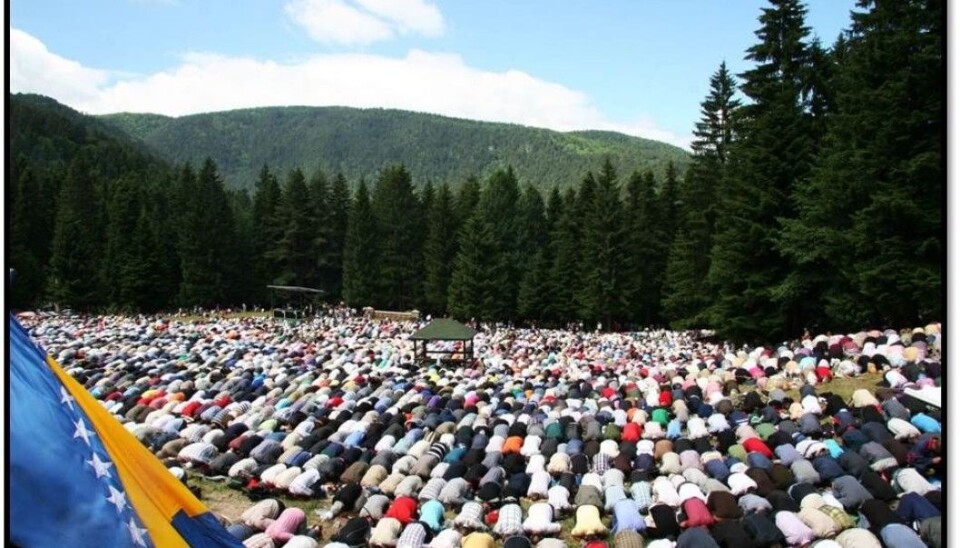An article from University of Oslo

Growing number of Muslim pilgrims in Europe
Pilgrimages have become more popular all over the world in recent years. New pilgrimage sites are emerging and in Europe Muslims and Christians are visiting each other’s pilgrimage sites.
European Muslims have increasingly been visiting pilgrimage sites in recent years, and Mecca is not the only one that matters.
“We are seeing new Muslim pilgrimage practices being established in Europe. People are still travelling to well-established pilgrimage sites in Asia and Africa, but new pilgrimage sites are also emerging in Europe and old sites are being renovated.”
Ingvild Flaskerud is a researcher at the Faculty of Theology, University of Oslo. She has edited the book Muslim Pilgrimage in Europe together with her colleague Richard J. Natvig of the University of Bergen. Researchers from several European countries have contributed.
New pilgrimage sites emerging
The researchers have identified a number of trends: in recent years, Muslims have established a number of new pilgrimage sites, especially in Western Europe. This has happened in places where, for example, important religious figures are buried. In this way, Muslim immigrants are continuing old traditions with saints’ graves that can be found in South East Europe, Asia and Africa.
“We are also seeing the emergence of common Christian and Muslim pilgrimage sites. For example, in Brittany in France, a Christian pilgrimage site has been converted to a site for both religions due to the site’s connection to a story that is also found in Islam,” says Flaskerud.
New pilgrimage sites can strengthen the identity of a religious group but can also help build bridges between several groups, like in the example from Brittany.
Christians and Muslims visiting the same sites
In recent years, Muslims have also increasingly visited Christian pilgrimage sites, especially in Southern Europe, but also Nidaros Cathedral in Trondheim. And while Muslims are visiting Christian sites, Christians are also visiting Muslims ones, which can often also be found in South East Europe.
“It’s not strange for different religious groups to travel to the same sites. The sites are regarded as sacred and everyone can share in the holy power. This has roots all the way back to antiquity. People didn’t care who owned a holy site.”
“It is also easier to visit a pilgrimage site close to where you live than to travel great distances to reach another,” she adds. “Since more pilgrimage sites have emerged in Europe, it has become easier to visit them and this has resulted in greater interest.”
Old practices are being revived
In South East Europe, old pilgrimage sites have been revived after religious displays were forbidden under communism and socialism.
Rundown pilgrimage sites have been renovated and in countries such as Bosnia-Herzegovina and Albania people gather for pilgrim festivals in which politicians, religious leaders and popstars often participate. The festivals become gathering places where participants can choose what they want to take part in and thereby what they want to get out of their pilgrimage.
“In the Balkans these festivals become meeting places. Many migrant workers and refugees return to take part and the local communities in which the festivals are held are revitalised. This can mean a lot for small places that have experienced war and oppression,” says Flaskerud.
Become more socially engaged
Previous research into pilgrimages has often concentrated on the actual pilgrimage sites and what happens there. The research described in the book also covers what pilgrimages mean to people; the faith and expectations people bring with them and what they take home again. The researchers have interviewed Muslim pilgrims at various sites in Europe.
“Many feel that their faith has been strengthened after they have visited a pilgrimage site. However, the studies show that many also become more ethically aware and more socially engaged at home in their local communities. They start to think more about society as a whole rather than just their group’s well-being,” says Flaskerud.
For many, regardless of whether they travel to Mecca or to some site in Europe, pilgrimages are about peace, reconciliation and building bridges over differences and established boundaries. These can be boundaries between different religions or between different groups within their religion.
Participate in peace marches
“We often also see Muslim pilgrims combine their journey with taking part in a march for peace or other forms of civil engagement, for example, a meeting between different Muslim groups or a meeting between Christians and Muslims.
Besides this, people have various motives for going on a pilgrimage.
“A lot happens at pilgrimage sites. There can be seminars, festivals and concerts. You can go to expand your religious knowledge or to stay in contact with people, or perhaps to make new acquaintances,” says Flaskerud.
What does religion mean to people?
The book is the first to look at Muslim pilgrimage practices in Europe. Ingvild Flaskerud believes that the studies carried out by the authors provide a different approach to Islam than the perspective one often encounters in the media.
Instead of focusing on integration, politics or economics, the researchers have asked people what religion means to them. They also look at how religion is practised.
“Studies of pilgrimage practices provide a good opportunity to study how people manoeuvre in their religious and social lives,” says Flaskerud.
Studies from Bosnia-Herzegovina in particular show that people arrive at the pilgrimage festivals there with varying expectations. Some take part for political reasons, while others want to get something spiritual out of it. Thus, the potential for discord and disagreement as a result of pilgrimage festivals also exists, which must be dealt with,” points out Ingvild Flaskerud.
“We can also see that local pilgrimage sites are visited often. They are becoming part of the everyday religiousness rather than an annual occurrence or something one does only once in one’s life.”






























